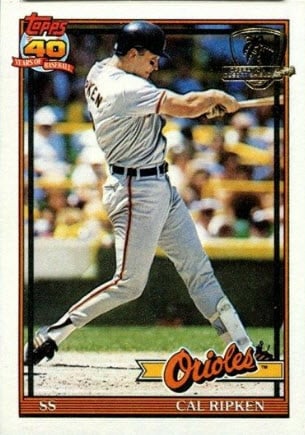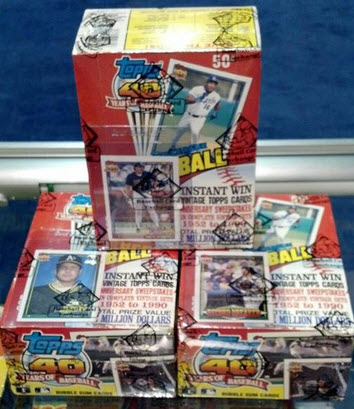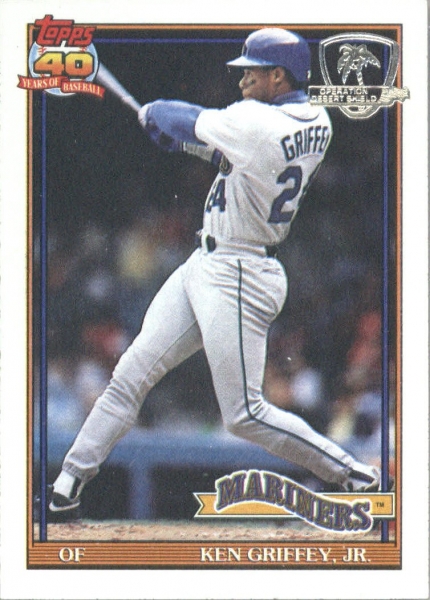30 Years Later, 1991 Topps Desert Shield Cards Remain Popular — and Valuable

Contents
It’s hard to believe but the 1991 Desert Shield baseball cards issued by Topps have turned 30. I remember those cards distinctly, even if finding them proved difficult.
Here’s a closer look at this impressive set that continues to generate collector interest three decades after it was first issued.
About the 1991 Topps Desert Shield Baseball Cards
The cards, if you’re unfamiliar with them, are moderately rare. Calling them scarce would a bit much, even if many of the roughly 6,500-7,000 of each player estimated to have been printed were discarded. You can, after all, routinely find thousands of them on eBay. But compared to other cards in the junk wax era, the ‘somewhat rare’ moniker probably fits.
So what are these cards? Back in 1991, Topps issued them as a parallel to their regular baseball cards. The cards are virtually identical to Topps’ regular cards from that year. However, they have a special gold foil stamp on the front of them with a palm tree inside of a shield. The cards were originally intended for soldiers in Operation Desert Shield, a mission to prevent Iraq from invading Saudi Arabia. However, while some of them made their way overseas, there are reports of others remaining here in the states.
They must have found their way into the hands of collectors quickly because I remember seeing them for sale at shows at the time. But make no mistake — in 1991, these were not terribly easy cards to find. The biggest reason for that was the lack of a widespread internet. Collectors had to go to great lengths to find the cards back then. At the time, most relied upon local card shops, shows, or mail orders.
The set was also special as Topps celebrated its 40th year of issuing baseball cards. To pay homage to that longevity, they added a 40th Anniversary logo on the cards and that is found in addition to the Desert Shield stamp.
As you can imagine, not all of the soldiers were into these cards. An earlier Sports Collectors Daily article with a first-hand account from a soldier in the Middle East mentions cards being thrown away and even burned as part of fires. Topps’ gesture would have been appreciated, surely, but, well, troops had bigger issues to worry about. And as the article points out, even the ones that did legitimately enjoy the cards may have found it challenging to bring them home or even keep them in decent condition. That helps to explain some of the rarity of this set.

In all, there are 792 cards in the set, just like the ‘regular’ 1991 Topps baseball cards. And since complete sets of the Desert Shield cards were never issued, finding those today is very difficult because they were required to be hand-collated. You do see sets for sale on occasion (more on that in a bit), but it doesn’t happen all that often and usually requires not only a collector with some patience, but one with a little bit of money to spend.
The cards are a trademark Topps issue printed on non-gloss cardstock. That would change in 1992 as the company would follow the trend of other modern issues and move to a light-gloss style of card. Fronts included full color images of players with white borders while backs had the typical statistic-laden layout found on Topps’ other sets.
Keys to the Set

The main cards in the set essentially parallel those found in the main 1991 Topps baseball card set.
The top card in the set is easily the rookie card of Hall of Famer Chipper Jones. The card of Jones, an eight-time All-Sar and former Most Valuable Player, has become of one of the more sought after cards in the junk wax era — particularly in high-grade condition.
After Jones, other big name stars present themselves. Among the more popular ones are Ken Griffey, Jr., Nolan Ryan, Cal Ripken, Mark McGwire, Frank Thomas, Barry Bonds, Roger Clemens, Sammy Sosa, and others.
Jones’ rookie card is one of the few notable ones. Collectors will also find a rookie of two-time All-Star Carl Everett, but even that card has minimal value. Most of the prized rookies from 1991, including Jeff Bagwell and Ivan Rodriguez, were not issued until the Topps Traded set was released later in the year. The highlights of the checklist are really the rookie card of Jones and the big-name cards of veterans.
Pricing and Rarity

As mentioned, it is believed there were roughly 6,500-7,000 of the cards printed for each player. Sources vary on the exact distribution but that is the figure most commonly cited. However, we also know that many were discarded . That meant several never really made their way into the circulation of collectors.
How many exist today, really, is anybody’s guess. Even the population reports are not terribly helpful since a large number of these cards remain ungraded. Many cards are inexpensive and simply not worth the time to grade.
Despite that rarity, many of these cards are very affordable. Raw commons in the set typically start in the $2-$4 range and many minor stars can be purchased for under $10. So why is the set so expensive? Because there are nearly 800 cards, obviously. Then, there’s the Chipper Jones card, with graded examples usually running close to $1,000 or more. A few of the biggest stars can easily sell for $100 or more.
A complete raw set sold for nearly $3,000 in September on eBay. That said, prices for graded cards will increase the price in a hurry. How high can these cards rise? In 2018, the No. 1 set on the PSA registry with an amazing 759 of 792 cards graded a PSA 10 sold at auction for over $106,000.
Additionally, unopened product is sometimes found. A completely unopened wax box of 36 packs was sold in December 2020 by Heritage for $30,000. Given the increasing prices of high-grade cards, the potential for unopened packs and boxes could be even greater by now.
One thing to watch out for? Counterfeits. This PSA article, in part, details several types of counterfeit Desert Shield cards with fake foil stamps. And while it is probably less common to find counterfeits of the lesser names, the Jones card, in particular, is often a target to be forged.





